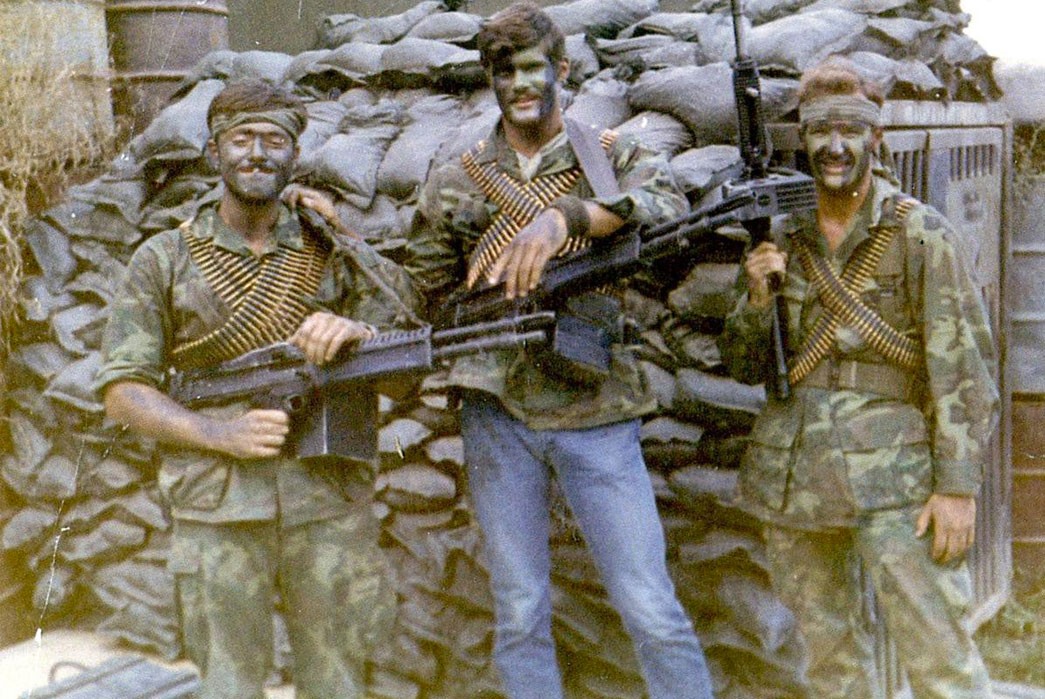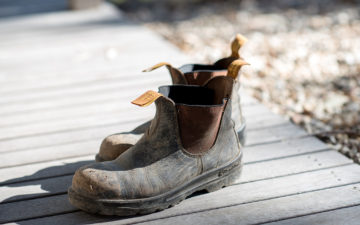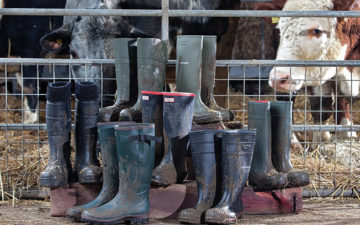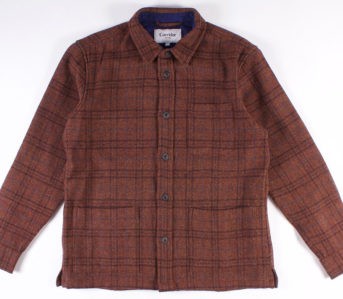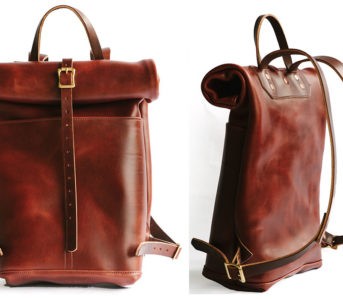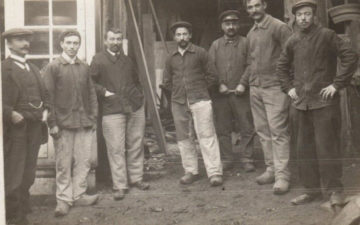This piece comes to us from Chris Danforth, an independent writer and researcher based in Berlin who discovered the story while researching brands that have supplied the US Military and inadvertently coming across an image of SEALs wearing blue jeans. You can follow Chris on Instagram and find more of his writing on Medium.
The highly trained and elite United States Navy SEALs were nicknamed “the men with green faces” by the Viet Cong army, due to the frightening camouflage face paint SEALs wore during operations.
They were also the men with blue jeans.
In the Vietnam War, Navy SEALs (Sea Air and Land Teams) operating in Vietnam did not abide by the same rules as the standard Marine Corps. SEALs acted on their own intelligence networks, managed and deployed their own personnel, and even chose their own gear. It wasn’t uncommon for SEALs to be specially equipped, touting heftier arms like the Stoner modular weapon system, and donning “Coral Boots.” Former Vietnam SEAL Roger Hayden summarized the SEAL uniform in Vietnam by noting, “You would see guys with Coral Boots on, with their Levi’s and their Rolex watch. You could pick out a [SEAL] in a heartbeat.”
In Vietnam, some SEALs preferred American-made Levi’s 501 and 505 denim jeans instead of standard issue dungarees. Specifically during late 1970 and early 1971, SEALs donned Levi’s jeans in combat. Denim could better withstand the rigors of the jungle climate, providing improved protection from leeches, mosquitos and other bugs, especially when combined with a layer of pantyhose underneath. Anecdotes also tell of soldiers customizing the Levi’s 5-pocket design by sewing on additional pockets made from camouflage fabric.
Camouflage guru Hardy Blechman of streetwear brand Maharishi told me over email, “I have seen examples of SEALs in Levi’s, and seen rare examples of Levi’s with camouflage/ERDL cargo pockets attached to them,” before pointing me toward the US Militaria forum. On the forum, a member named SEAL76 commented on a gear-related topic thread, “I wore Levis [sic] 501s with pockets from ERDL blouse sewn on. I tucked the jacket/blouse into my jeans.”
An excerpt from ‘Men in Green Faces,’ penned by former SEAL Gene Wentz, details one operation-specific SEAL loadout from Vietnam, “Everyone in the patrol will have cami tops, pants — Levi’s 501s or cami bottoms — jungle boots, insect repellent, first-aid kits, UDT SEAL life jackets, knife, UDT emergency flare, and green and black face paint.”
Retired Captain Rick Woolard, who commanded two SEAL platoons in Vietnam, told me via the The National Navy SEAL Museum, “I tried Levi’s and did not find them as comfortable or functional as jungle cammies, but did not object to my men wearing them. New jeans were pretty stiff, and you definitely wanted a pair that was well broken in.” He suggested blue jeans were more of a “style points” thing, like bandanas, beards, and long hair.
For a six or nine-month tour, SEALs were usually issued a few sets of standard attire, nicknamed cammies. Levi’s had no direct involvement with SEALs wearing Levi’s jeans, which were a private-purchase item.
Levi’s historian Tracey Panek told me “LS&Co. [Levi Strauss & Co.] sold products at PX stores on military bases so SEALs could have purchased them on base.” PX stands for Post Exchange, a type of retail store operating on United States military installations worldwide. But in some cases, Levi’s were impossible to obtain, for example as a SEAL stationed on Sea Float, a Mobile Advanced Tactical Support Base (MATSB), which was a small group of pontoons on river Song Cau Lon in Vietnam.
Jonathan Cheung, former-Head of Global Design at Levi’s, noted to me while still working for the brand, “I’ve seen images of special forces operators wearing Levi’s. It doesn’t surprise me. I would say that the button fly is probably more reliable than a zipper, as the dirt could cause zip malfunctions.
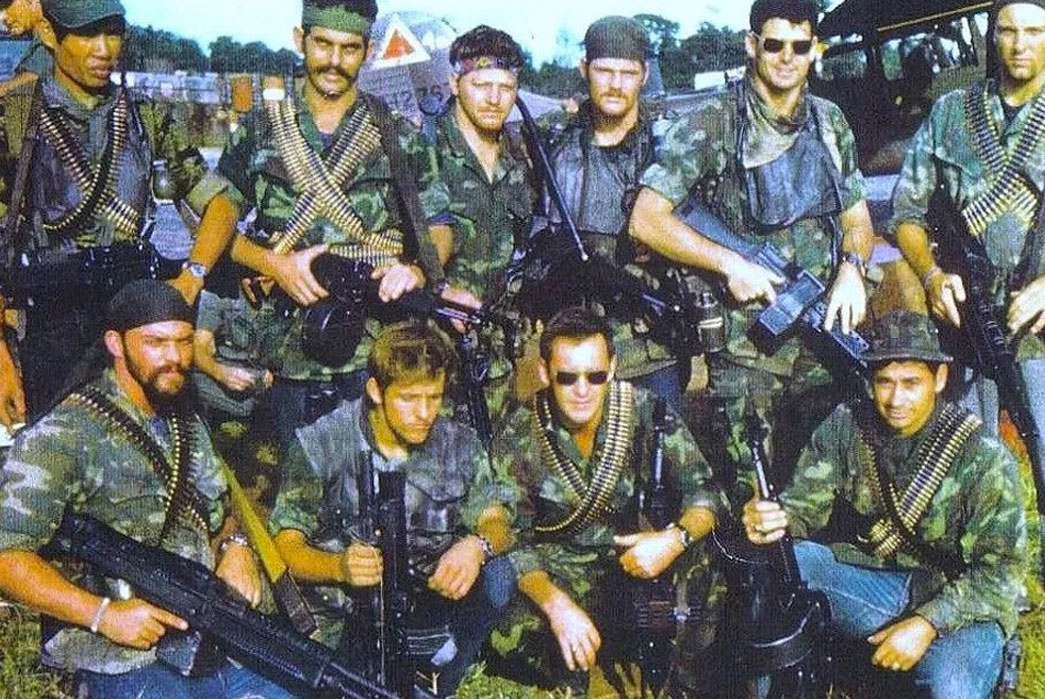
Image via U.S. National Archives and Records Administration (SEAL Team One)
Opinions differ on zipper fly versus button. Some argue; no zipper means no noise. Others like ex-SEAL Roger Hayden advocated for zipper, strongly stating, “You wanted the zip-up blue jeans, not the button-up, because they also kept leeches off. If you had the button-up ones, you were screwed.” In his book, Gene Wentz argues the opposite, that a button fly is preferred because it’s quiet.
Back on US Militaria, a user named Spike joined the forum in 2007, he’s an avid collector of Vietnam-era military combat gear. His real name is Mike, and he tells me, “At some point, some SEAL decided that Levi’s would be a better choice for pants that could take the abuse that SEALs routine dealt with. Every platoon would tell the new guys going over, this is what worked, this is what didn’t. Levi’s were a bit of a fashion statement, as SEALs were the only guys in Vietnam using them in a combat environment.”
The following are anecdotes and insights from former Vietnam SEALs:
“Durable, drained faster, didn’t snag, quieter, most ops were at night so wearing cami (camouflage) pants wasn’t necessary.” -Anonymous member of X-Ray platoon 1970/71.
“One reason was the legs were tighter and didn’t rub and make noise when you walked, especially when wet.” -Anonymous member of Mike platoon 1971.
“Levi’s were tighter, tougher, and were easy to take care of. Wash ‘em in the shower after your op.” -Anonymous member of Zulu platoon 1970/71.
In Vietnam — as strange as it may sound, during a conflict that changed the landscape of warfare — Levi’s became more than a utilitarian part of SEAL combat uniforms, they were actually a status symbol, even a fashion statement item in the middle of a deadly conflict.

